Oliver Wunsch
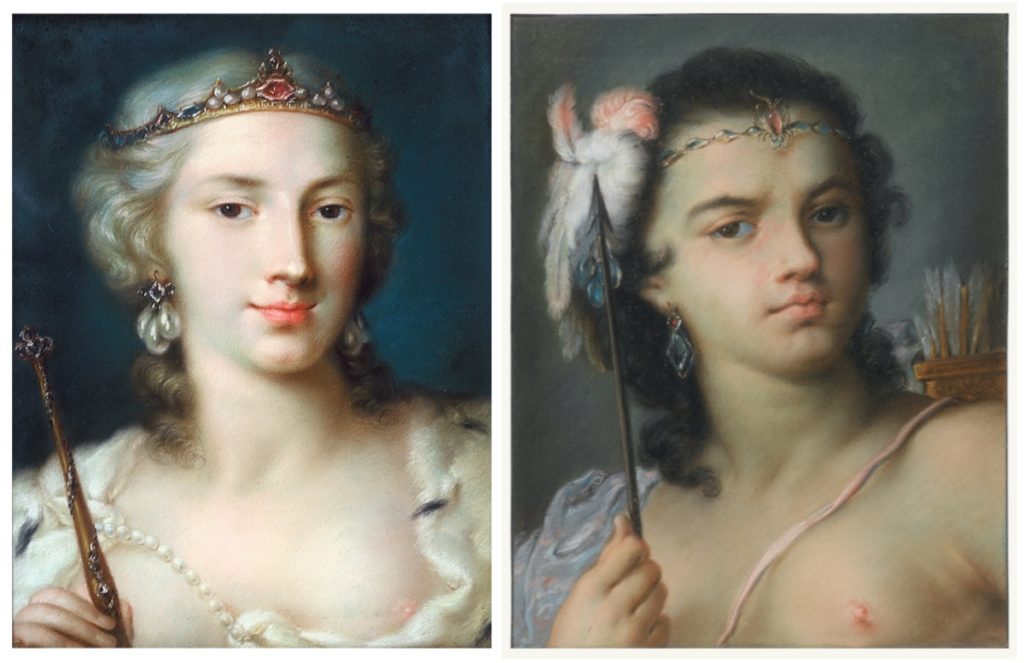
RIGHT: Fig. 2. Rosalba Carriera, Personification of America, ca. 1720. Pastel on paper mounted on canvas, 44 x 34 cm. Cooper Hewitt, New York. Artwork in the public domain; photograph provided by the Smithsonian.
Among the many allegorical representations of the “four continents” created by European artists, Rosalba Carriera’s contribution stands out (Figs. 1-4). Little is known about the circumstances of the commission, though art historians suspect that the Venetian pastellist created her series sometime after her formative trip to Paris in 1720.[1] Carriera’s brother-in-law, the painter Giovanni Antonio Pellegrini, was then completing the ceiling decorations for the Royal Bank of France, which included personifications of the “diverse nations of the world.”[2] Carriera visited the bank more than a dozen times before the ceiling was destroyed, and she perhaps drew inspiration from Pellegrini’s allegorical evocation of global commerce.[3] Whether she looked to her brother-in-law’s work or to the many decorative schemes involving the four continents that appeared in European palaces and churches around this time, Carriera had ample sources of inspiration at her disposal.[4] In translating this allegorical tradition to the intimate format of pastel portraiture, however, Carriera brought to the continents an unusual attention to the specificity of each face, paying unique attention to differences in complexion.
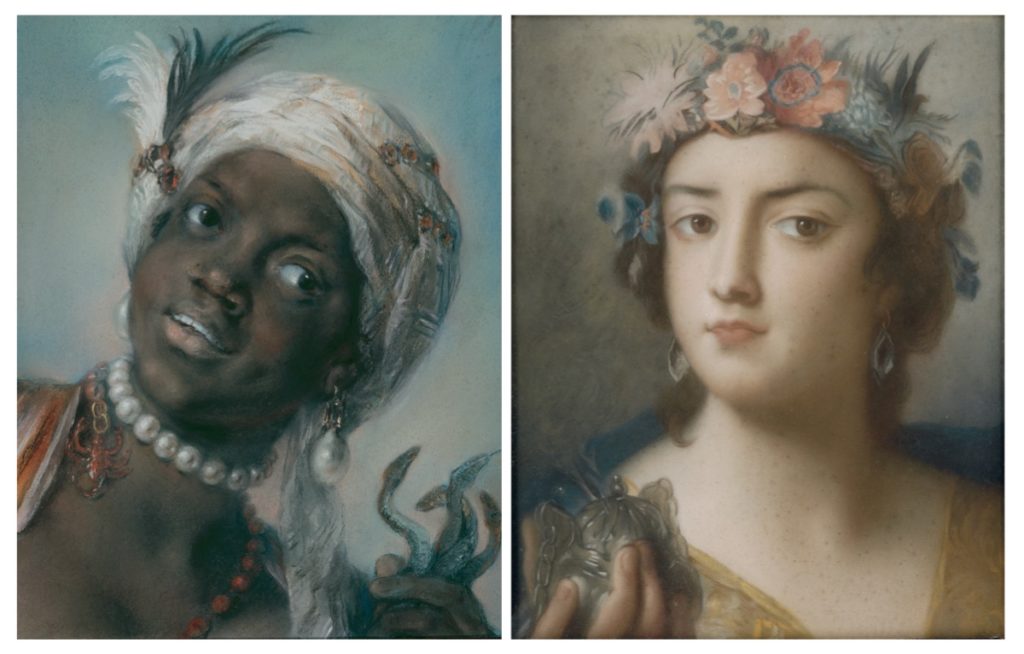
RIGHT: Fig. 4. Anonymous artist after Rosalba Carriera, Personification of Asia, ca. 1720. Pastel on blue paper, 36 x 30 cm. Private collection. Photo © Christie’s Images/Bridgeman Images.
Recent scholarship on the visual representation of skin color in eighteenth-century Europe has emphasized the links between artistic practices and emerging conceptions of race.[5] A closer look at Carriera’s Continents reinforces these ties, highlighting suggestive areas of overlap between Carriera’s work and new paradigms of human difference. Yet Carriera’s work shows the difficulty of establishing causal relations between art and the broader discourse on skin color during the period. Carriera did not set out to create anatomical illustrations, and her approach to her subject needs to be understood in the context of her ambitions as an artist seeking to make a living in the novel medium of pastel. As Carriera adapted contemporary notions of skin color to advance her professional goals, she also transformed these ideas, characterizing the skin of each continent with a subtlety uncommon in period commentary on complexion. Examining the technical and commercial factors behind Carriera’s Continents reveals how demand for novel surfaces and materials in the early eighteenth-century art market shaped the artistic construction of racial categories. It also demonstrates how artists could exploit the art market’s growing emphasis on materiality and close looking to produce—and profit from—dermal distinctions not yet widespread in the broader European discourse on skin color.
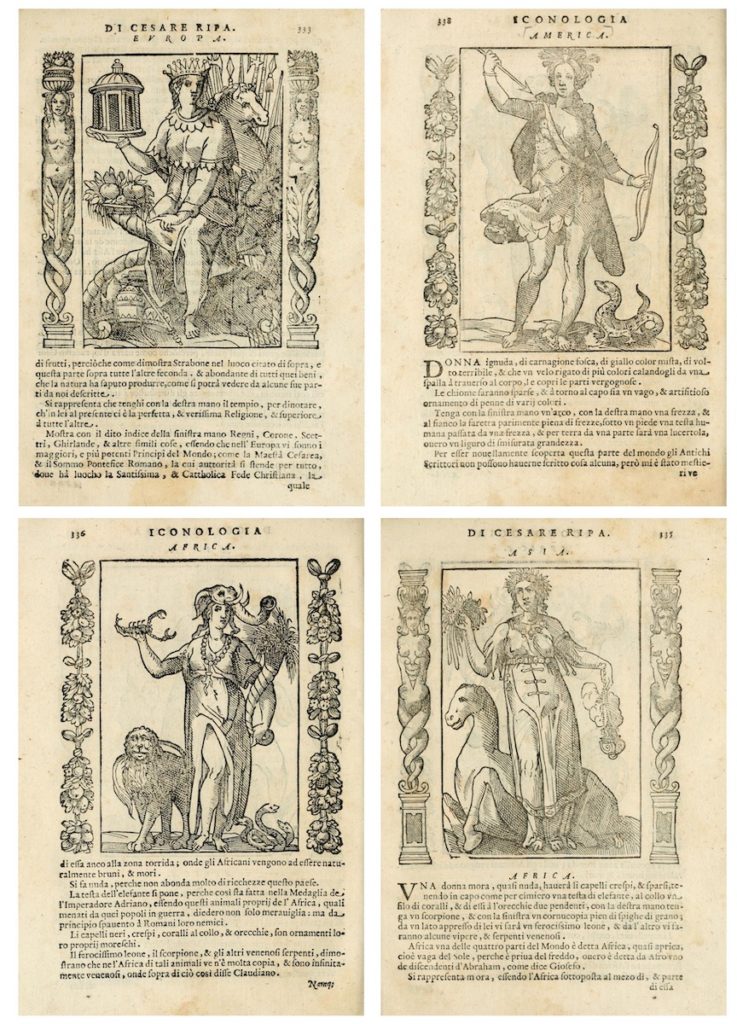
To appreciate the distinctive qualities of Carriera’s Four Continents, we first need to put them in the context of their iconographic precedents. Versions of the subject date to the sixteenth century and the first European voyages to America.[6] Emblem books, such as Cesare Ripa’s Iconologia, soon codified the traditional attributes of each continent (Figs. 5-8). Europe’s crown and assortment of weapons assert her status as the omnipotent queen of the world, while the temple in her hand stands for the “true church” of Christianity.[7] The three other continents bear attributes that reflect the threats and material rewards that Europeans saw across the globe: Asia carries an incense burner to symbolize the smell of perfumes and spices; Africa wears a coral necklace while menacing animals, such as snakes and a scorpion, appear at her side; America wields a bow and arrow, with a pierced human head underfoot. From the outset, then, depictions of the continents were bound to the history of colonialism, presenting the world as a bountiful yet uncivilized domain to be cultivated through Europe’s religious, military, and commercial influence.
What had not yet been refined, however, was the role that bodily difference might play in such a system of global domination. Ripa’s continental prototypes, for example, make no attempt to differentiate the four women’s anatomy, facial structure, or skin color. This physical uniformity stems, in part, from the traditions of allegorical representation in which the Classical ideal of a female body functions as a stock mannequin on which to hang the symbolic attributes of whatever subject is being allegorized.[8] The decision to leave Africa’s skin white may also relate to the technical properties of woodcut printmaking, which did not lend themselves to reproducing tonal variation.[9] But the homogeneity of the figures also suggests that the bodies of the continents, unlike the various commodities and natural resources that surround them, had not yet been fully assimilated into the logic of colonial commerce. The cornucopia under Africa’s arm indicates the plenitude of the region’s land, but she herself remains an indistinct cipher—not yet a body to be consumed.
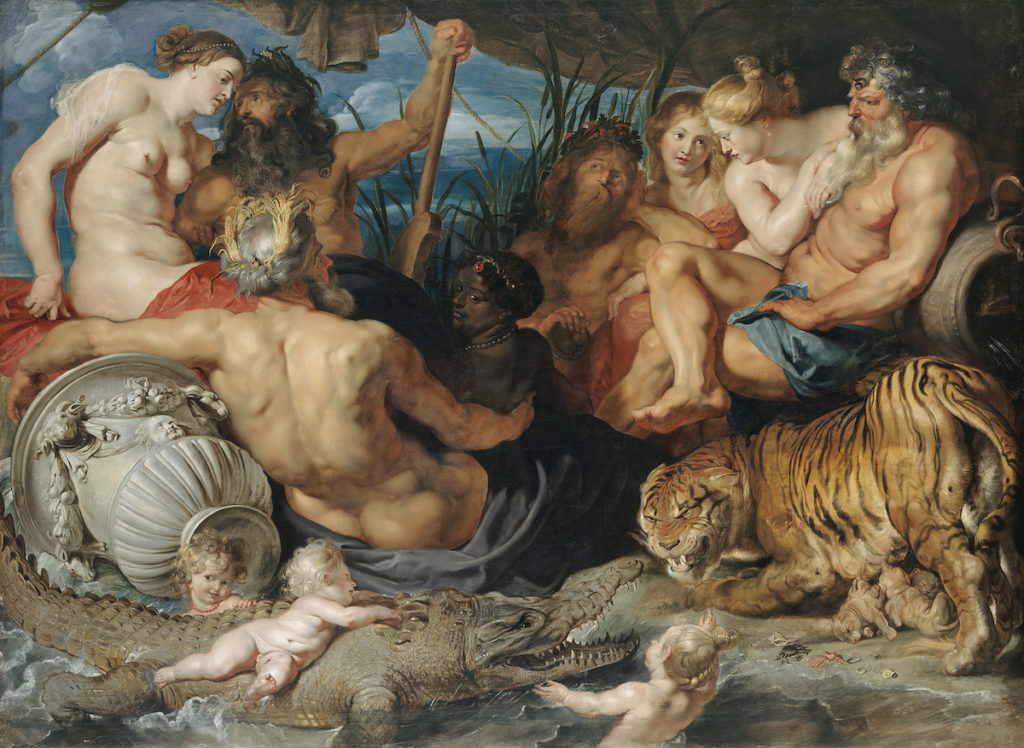
Throughout much of the seventeenth century, even as the transatlantic slave trade accelerated, skin color played an inconsistent role in geographic allegory.[10] Peter Paul Rubens’s Four Rivers (Fig. 9), for example, personifies the Nile as a white man but gives his guarding nymph a brown complexion.[11] Rubens was deliberately ambiguous in defining the woman’s features and skin tone—when representing figures with dark skin, he drew upon a Classical understanding of “Ethiopian” identity that included people from South Asia as well as Africa.[12] Rubens’s repeated use of such subjects to produce sensuous surface effects nonetheless indicates how new modes of spectatorship that developed in the collecting culture of the seventeenth century prompted artists to take greater interest in global variation in skin color.[13] An instructive example is the series of four continents painted by Jan van Kessel the Elder between 1664 and 1666, which appealed to a growing market of private collectors who pored over paintings and natural curiosities in appreciation of their material properties.[14] Skin color remains one visual feature among many in the riot of visual information that Kessel presents, and it is treated variably; America (Fig. 10) includes figures with wide-ranging skin colors, alluding to—or perhaps confusing—the continent’s mix of Indigenous and diasporic populations.[15] Regardless of these ambiguities, the work conveys how the intimacy of small-scale paintings designed for luxury consumption allowed artists to exploit skin color as a means of seducing the eye. Even if European audiences had not yet granted the complexion of the continents privileged significance, collectors and connoisseurs had begun to cultivate the habits of close looking they would soon direct at skin color with new intensity and purpose.
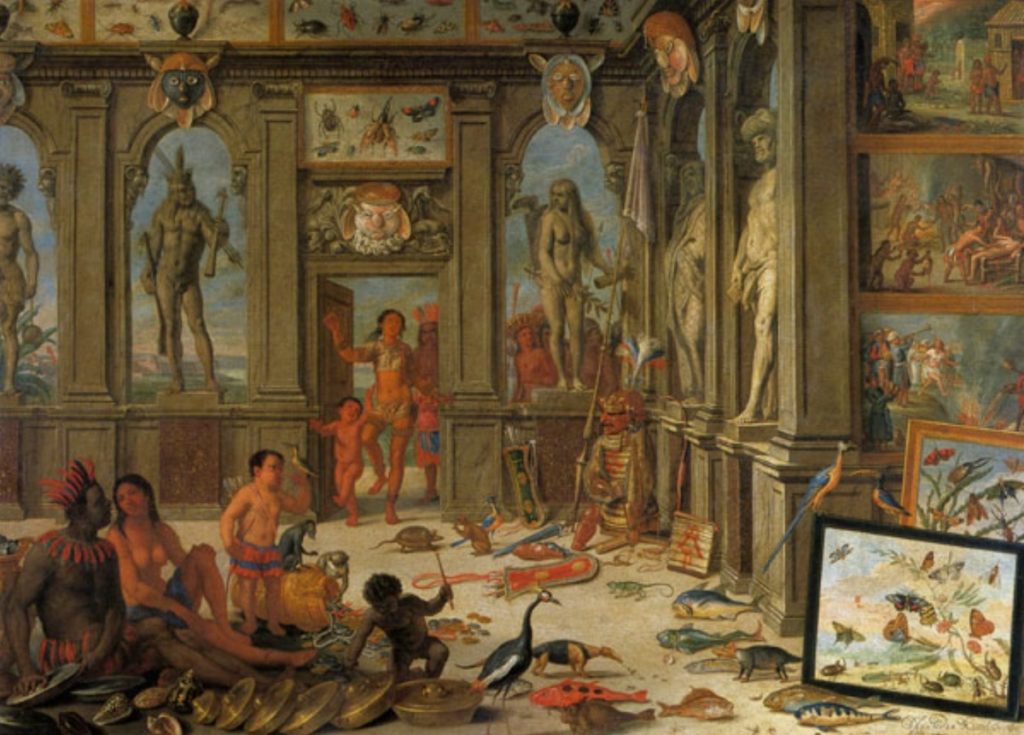
Rosalba Carriera was attentive to the demands of this market. The start of her career coincided with a period of declining institutional patronage in Venice, forcing artists to rely on a private clientele from across Europe.[16] Sensitive to the growing importance that collectors placed on the materiality of art, Carriera showed a penchant for technical experimentation, helping to transform pastel from a tool reserved for preparatory studies to an autonomous medium appreciated for its velvety textures and ethereal hues.[17] Carriera maximized these effects in her depictions of nymphs and goddesses (Fig. 11), whose delicately rendered skin offered her predominately male audience the opportunity to integrate the processes of aesthetic discernment and libidinal delectation.[18] Her approach to the Continents, in which she juxtaposes expanses of flesh with sensuous materials ranging from ermine to feathers, is consistent with the genre. The resulting compositions, however, represent a significant departure from the iconographic tradition of the continents. Carriera pushes the traditional attributes of each continent to the margins of the frame, relying instead on skin itself as a primary means of distinguishing each figure. Europe bears the whitest skin, while America takes on a reddish hue; Asia’s complexion is tinged with olive, and Africa’s face is a mix of browns.
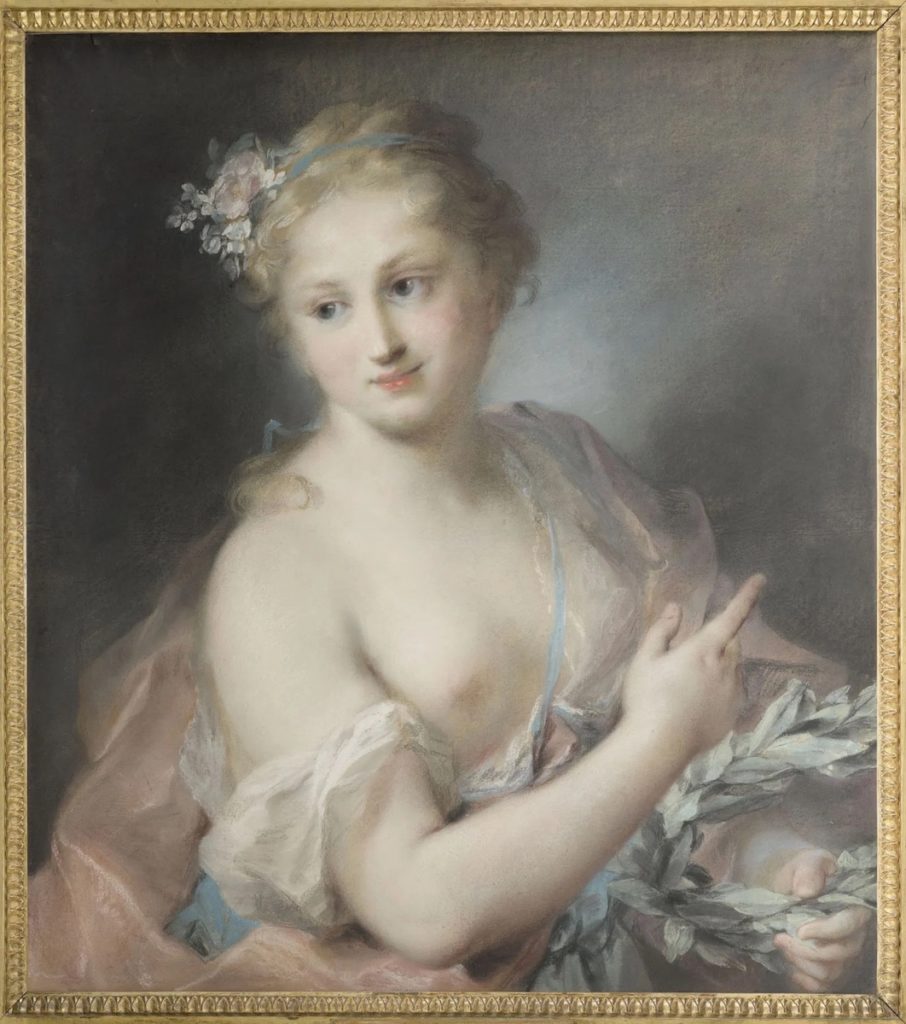
In drawing these distinctions, Carriera invited her viewers to exercise a form of visual discrimination that they had only recently begun to hone. Europeans at the turn of the eighteenth century were just starting to construct the fiction that people across the globe belonged to distinct racial categories that could be discerned from appearance.[19] Historians typically trace this modern understanding of the word “race” to a 1684 essay by the French physician and traveler François Bernier entitled “A New Division of the Earth by Different Species or Races of Men.”[20] Bernier outlined what he understood to be four or five different categories of humans, each defined by unique physical characteristics, such as skin color and facial structure. His logic was incoherent, and most present-day readers would find his categories puzzling (for instance, Bernier describes the Indigenous population of Scandinavia as its own race while categorizing Europeans with many South Asians). And yet, Bernier’s supposition that humanity could be sorted according to visual features, and his belief that physical traits were inherited rather than products of climate, exemplified a mode of bodily typology that was coming to play an increasingly important role in European consciousness.[21]
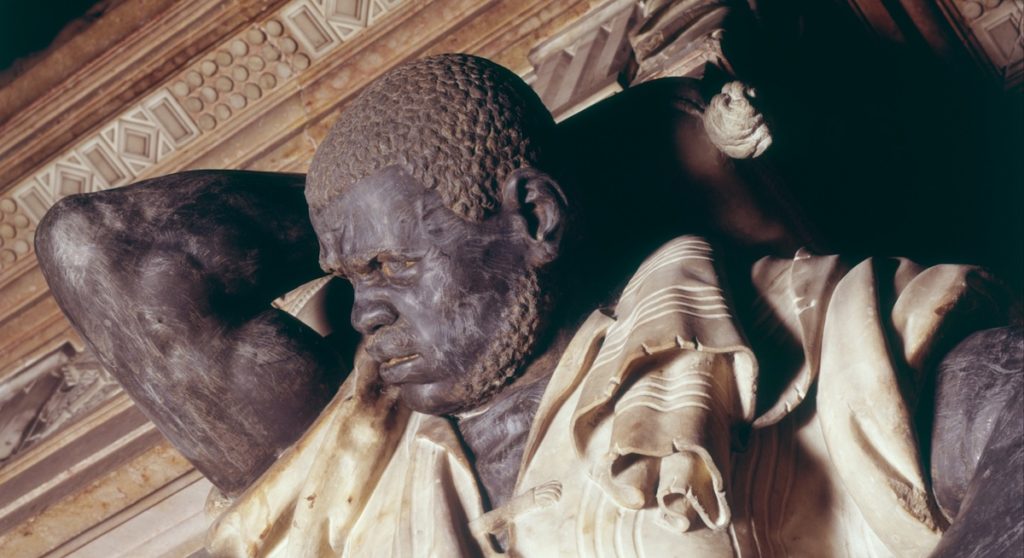
Carriera’s depiction of each continent’s physical attributes makes clear that she was conversant in the tropes of bodily difference that appeared with growing frequency in writing from the period. Her depiction of Africa, for example, closely corresponds to attributes noted by Bernier in his description of African people, such as his emphasis on “their fat lips and their flattened nose.”[22] Carriera may also have drawn inspiration from seventeenth-century Venetian depictions of Africans, including the 1669 Tomb of Doge Giovanni Pesaro where the physiognomically exaggerated faces of African men are rendered in black marble (Fig. 12).[23] Carriera’s decision to show the teeth of Africa—the only continent in the series whose lips are parted—is equally revealing. Africa’s smile was not an established element of the four continents iconography, but it had begun to occupy an important place in racial pseudoscience. Bernier’s description of African people repeatedly references the appearance of their teeth, describing them as “whiter than the finest ivory.”[24] The analogy to ivory, a material that Europeans increasingly harvested from slaughtered elephants in Africa, was hardly accidental, implicitly linking the continent’s human and animal inhabitants.[25]
Other continents in Carriera’s series reflect a similar awareness of emerging stereotypes circulating among European authors. The androgynous appearance of America, for instance, alludes to a growing European conception of Indigenous American women as exceptionally strong. The seventeenth-century missionary Louis Hennepin provided an early example of the trope, writing that these “savage” women were “in some manners stronger and more robust” than men, explaining that the heavy loads these women carried gave them “such vigor that there are very few men in Europe who have as much.”[26] The “vigor” of Indigenous Americans soon became a regular feature of travel writing, repeated in French publications throughout the early eighteenth century.[27]
The most significant way that Carriera differentiated the bodies of the continents, though, was in her depiction of their skin color. In certain respects, Carriera’s attention to global variations in complexion is in keeping with the broader discourse on skin color from the period. Bernier had cited differences in complexion as a key piece of evidence for the existence of discrete human categories, and the origin of skin color had become the subject of extensive inquiry among anatomists by the late seventeenth century. [28] In 1665, the Italian physician and microscopist Marcello Malpighi published his influential conclusion that skin color stemmed from a distinct membrane beneath the outermost surface of the epidermis, and anatomists across Europe soon conducted dissections on the bodies of African people to discern the physiological differences between black and white skin.[29] Carriera may well have been familiar with this research, which was the subject of numerous publications aimed at a non-specialist audience.[30]
Such writings, though, do not account for the specificity with which Carriera characterized each continent’s complexion. The hues that Carriera used to represent the complexion of America and Asia are telling examples. As Renato Mazzolini has shown, the explosion of European research into the skin of African people during the eighteenth century was not matched by comparable inquiry into the complexion of Native American or Asian people.[31] The association of Native American skin with red was just beginning to emerge at this time and only became conventional in the second half of the eighteenth century.[32] Carriera would have found even less guidance in existing literature on the skin color of Asian people. The very idea of ascribing a single skin color to the entire continent of Asia diverged from period commentary, which tended to distinguish between the appearance of South and East Asians.[33] The mix of pink and reddish browns that Carriera used to create America’s skin and the grayish-green tinge that she gave to Asia were therefore inventions as much as they were illustrations of preexisting ideas.
In depicting Africa, Carriera also deviated from period commentary in notable ways. Around the woman’s cheeks and eyes, Carriera added notes of red and blue, creating a range of warm and cool tones with nuances rarely expressed in European writing on Africans.[34] When European anatomists and travelers attempted to describe the skin of African people beyond categorical references to “blackness,” they tended to emphasize different properties from those that Carriera highlighted. Bernier, for example, described the skin of African people as “oily, smooth, and polished.”[35] Other writers similarly characterized African complexion as oily, sometimes claiming that this quality stemmed from fatty cosmetics applied to the skin and other times stating that it originated in the secretions of the skin itself.[36]
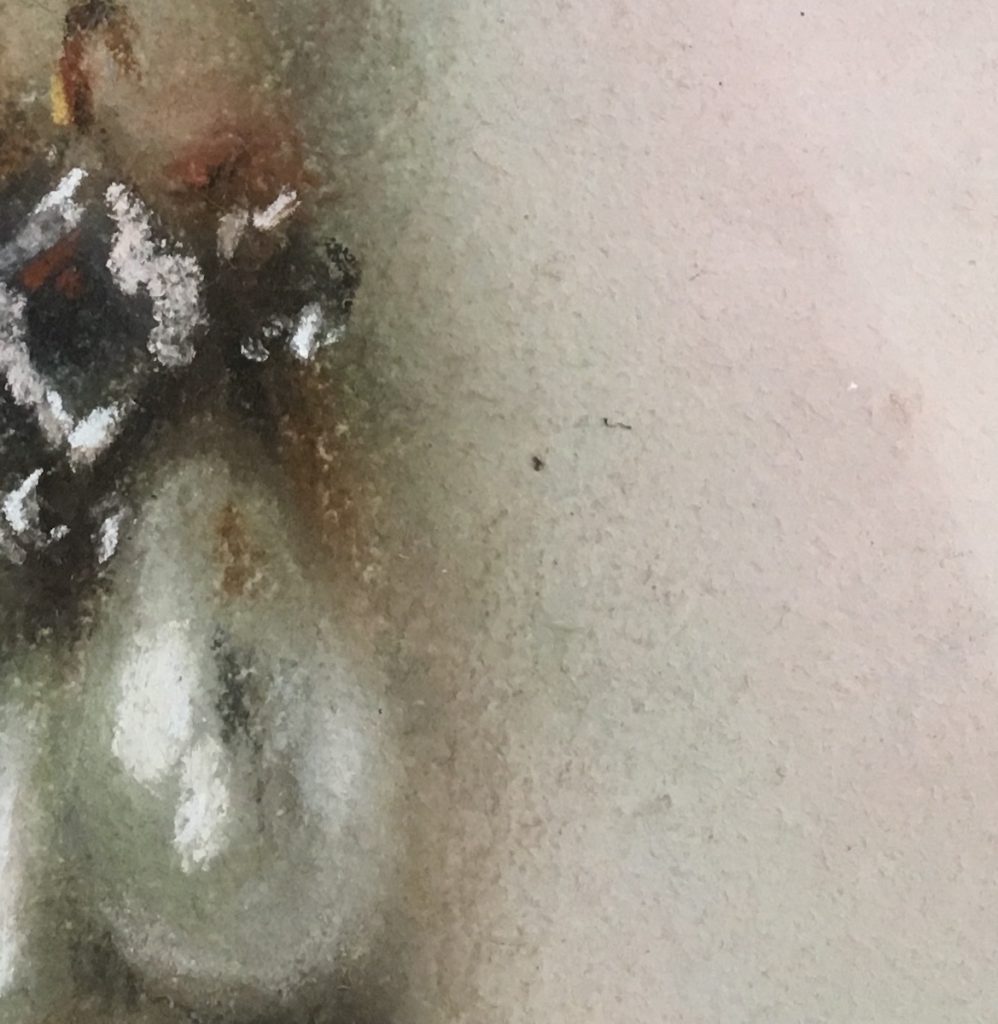
If Carriera had wanted to represent oily skin, her medium would have made it difficult. One of the distinctive properties of pastel is the matte texture that results from its three main ingredients: ground pigment, a white filler such as gypsum, and an adhesive that binds them together.[37] When applied to paper, pastel creates a powdery blanket of color that appears illuminated from within, as light penetrates its particles and diffuses in every direction instead of reflecting off the surface. Eighteenth-century Europeans prized the result, which they regarded as uniquely capable of mimicking the appearance of their skin. As the connoisseur and amateur pastellist Paul Romain Chaperon declared, “nothing comes as close to nature. Nothing produces tones so true. It is flesh, it is Flora, it is Aurora.”[38] The similarity between pastel and the powdery makeup that Europeans commonly applied to their faces amplified the illusion.[39] Carriera was among the first artists to demonstrate these technical possibilities, combining the textures of pastel and paper to simulate the appearance of cosmetic particulate on white skin (Fig. 13).[40] She developed a reputation for her unparalleled ability to depict the ineffable qualities of white complexions, and her suppliers made sure to send her an ample array of white and pink pastels for this purpose.[41] Even Carriera’s first name—Rosalba—connoted this talent; literally meaning “rose dawn,” its evocation of radiant pink and white light struck her contemporaries as almost too good to be true.[42]
As an artist seeking to sell her audience these abilities, Carriera must have realized that she needed to be selective in engaging with contemporary descriptions of global complexion. She had little incentive, for instance, to recreate the exaggerated and often grotesque qualities that anatomists assigned to the skin of African people. What the broader discourse on skin color offered Carriera, then, was not so much a list of visual qualities to replicate, but an approach to looking that she and her clients could bring to bear on the continents. As Carriera varied the skin tones of her allegories, she could be sure that members of her audience would be guided by a new belief that global variation in complexion constituted a site of visual inquiry that was rich with meaning and significance. Her pastels provided viewers the opportunity to conduct the kind of empirical study of skin that anatomical and travel writers had made fashionable, even if her depiction of the continents did not precisely match the qualities noted in those texts.

One close textual parallel to Carriera’s continents, however, needs to be noted. Carl Linnaeus’s 1735 System of Nature divided humanity into four categories defined by skin colors that correspond to the complexion of Carriera’s allegories: the “whitish” European, the “reddish” American, the “tawny” Asian, and the “blackish” African.[43] There is, though, no reason to suspect that Linnaeus had any direct influence upon Carriera’s work, which she likely produced before his publication. If anything, the line of influence went in the other direction: scholars speculate that Linnaeus may have arrived at his classificatory scheme through his familiarity with the artistic tradition of the four continents, which provided him with a convenient framework on which to hang half-formed theories of physiological difference.[44] The frontispiece to his botanical publication Hortus Cliffortianus included personifications of the continents, whose skin the engraver differentiated through tonal modulation—an effect that was reinforced in hand-colored editions (Fig. 14). This dialog between artistic and scientific conceptions of skin color suggests the ad hoc way in which racial categories took shape in the early eighteenth century, as artists and naturalists borrowed conventions from each other to suit their purposes. It also underscores how the formal and technical conventions of artists, no matter the intention behind them, could have a powerful effect on how their audience conceived of race and skin color.
Whether or not Carriera set out to create a new schema for categorizing humanity, she relied on clients who had every incentive to see such divisions in her work. Her 1720 Parisian sojourn made these circumstances abundantly clear. Carriera arrived in Paris at the height of speculation in French colonial enterprises, and her patrons included the mastermind behind this transformation of the French economy: the Scottish banker John Law.[45] Whether through her personal interactions with Law or through her close relationships with investors in his enterprises, Carriera was surely familiar with the global vision of commerce that Law and his associates promulgated. By the time of Carriera’s arrival in the French capital, Law had secured a royal edict granting him nearly complete control over French overseas commerce, consolidating numerous trading companies under a single entity that stretched, in the words of the decree, “to the four corners of the world.”[46] At the heart of Law’s arrangement with the state was a key requirement: “to transport at least 6,000 whites and 3,000 blacks” to French colonies in North America.[47] Behind this laconic proviso was a brutal reality. Since the seventeenth century, France had relied on a variety of strategies to provide labor for its colonies, bringing indentured laborers from Europe while forcing Indigenous communities and African people into slavery.[48] Law’s company initially pursued a similarly mixed approach, but disease and malnutrition quickly killed much of the workforce in the Mississippi Valley, and surviving European laborers fled from the colonies with tales of a “Mississippian hell.”[49] These conditions compelled the company to rely increasingly on the enslavement of African people to replenish its labor supply, leading to growing French investment in the transatlantic slave trade.[50]
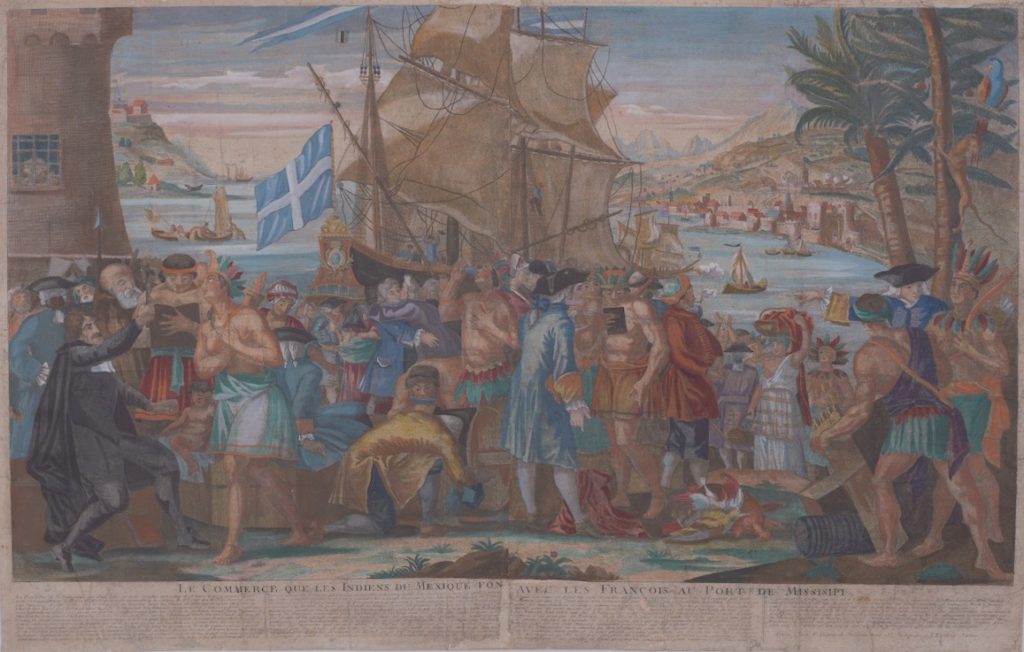
Carriera may not have been aware of the details behind this system, but she would have been well acquainted with the fictions that enabled it. To promote investment and resettlement in Louisiana, Law and his associates disseminated propaganda representing the lower Mississippi Valley as the site of a burgeoning global community where Europeans, Africans, and Native Americans coexisted in harmony, harvesting vast quantities of precious metals and other natural resources that would be shipped back to Europe.[51] A hand-colored print published by François-Gérard Jollain (Fig. 15), for example, presents New Orleans as a bustling commercial center where European traders interact peaceably with the region’s Indigenous inhabitants. The nearly naked, muscular bodies of the Indigenous Americans distinguish them from their European counterparts, as does their reddish complexion. In the foreground at right, a pair of particularly brawny men appear to move a piece of cargo for a European man who gestures towards his ship. Bare-breasted, Indigenous women hint at the carnal pleasures that Law’s propagandists promised to European men among the natives of Louisiana.[52] At left, a scantily clad woman professes her devotion to Christianity, her body sexualized but her soul redeemed. A fantasy of both bodily difference and assimilation, the image speaks to a moment when colonial enterprise depended on French comfort with a combination of slavery and interracial intimacy.[53]
Carriera’s Continents were not part of any explicit propaganda campaign. Yet Carriera worked for an audience whose eyes had been conditioned by such images and whose financial fortunes depended upon them. As the historian Arnaud Orain has recently suggested, Law’s economic regime was inseparable from new modes of representation: dazzling forms of culture convinced the public to buy into a system of global finance whose purported benefits similarly appeared to exceed rational explanation.[54] The beguiling surfaces of Carriera’s pastels were ideally suited to this context. Not only did they address the interests of an audience primed to assign new meaning to global variations in skin color, but they also presented such differences as a source of visual pleasure. As much as Carriera’s Continents invite the viewer to attend to differences in complexion, they also work to seduce the audience with delicate textures and modulated tones that reward close inspection. These two functions were closely linked. Scrupulous study of the continents’ skin color morphs into absorptive appreciation of Carriera’s technique, her handling of her materials and her refined touch.
In this respect, Carriera’s artistic purposes and the investments of her audience—literal and figurative—were strategically linked. While Carriera’s interest in the emerging discourse on skin color was clearly shaped by the exigencies of her medium and the aesthetic priorities of the period, she also must have understood that her sensuous depiction of skin offered her viewers something more than an object of connoisseurial satisfaction. Aesthetic discrimination easily mutated into nascent forms of racial discrimination, which were similarly defined by the quasi-empirical engagement with the visual and material properties of surfaces. To say that Carriera worked to establish the underpinnings of modern racism would distort her purposes, but it would also underplay the insidious effects of treating skin color as an object of aesthetic delight and artistic ambition. Carriera’s virtuosic technique did not make her capitalization on public fascination with skin color any more virtuous. By inviting viewers to treat global variation in skin color as an object of both visual pleasure and discernment, Carriera’s Continents encouraged a search for dermal difference that would have far-reaching consequences for a long time to come.
Oliver Wunsch is Assistant Professor of Art History at Boston College in Chestnut Hill, MA
Acknowledgments: I am grateful to Layla Bermeo, Nina Dubin, Meredith Martin, Aaron Wile, and the two anonymous Journal18 peer reviewers for their insightful feedback on drafts of this essay.
[1] For the association of the series with the Parisian stay, see Bernardina Sani, Rosalba Carriera: 1673-1757 : maestra del pastello nell’Europa ancien régime (Turin: U. Allemandi, 2007), 190-91; Andreas Henning and Harald Marx, Das Kabinett der Rosalba: Rosalba Carriera und die Pastelle der Dresdener Gemäldegalerie Alte Meister (Dresden: Staatliche Kunstsammlungen Dresden, 2007), 32; Valentine Toutain-Quittelier, Le carnaval, la fortune et la folie: la rencontre de Paris et Venise à l’aube des Lumières (Rennes: Presses universitaires de Rennes, 2017), 287. Carriera executed several versions of the Four Continents during her career. The earliest reference to the series in any inventory is the version listed in the collection of the Cardinal Silvio Valenti Gonzaga in Rome in 1760 (untraced). Another version was documented in the Electors’ gallery in Dresden in 1765; only the depiction of Africa from this version survived the Second World War. A third version of the series, thought to be by Carriera or a copyist from the period, is at the Cooper Hewitt in New York, but is missing Asia. Numerous other examples of individual figures from the series, either by Carriera or copyists, have appeared at auction. For each continent, I have elected to reproduce the example among existing works that appears closest to Carriera’s hand: Africa from Dresden; Europe and America from New York; Asia from a private collection. For full documentation of the many versions, see Neil Jeffares, “Rosalba Carriera,” in Dictionary of Pastellists before 1800, http://www.pastellists.com/Articles/Carriera2.pdf (accessed September 10, 2020), 14-16.
[2] The description was drafted by the Comte de Caylus and subsequently published in François-Bernard Lépicié, Vies des premiers peintres du Roi, depuis M. Le Brun, jusqu’à présent, 2 vols. (Paris: Durand, 1752), 2:122-37. On the ceiling program more generally, see Claire Garas, “Le plafond de la banque royale di Giovanni Antonio Pellegrini,” Bulletin du Musée Hongrois des Beaux-Arts xxi (1962), 75–93; Toutain-Quittelier, Le carnaval, la fortune et la folie, 193-221; Darius A. Spieth, “The French Context of ‘Het groote tafereel der dwaasheid’: John Law, Rococo Culture, and the Riches of the New World,” in The Great Mirror of Folly: Finance, Culture, and the Crash of 1720, ed. William N. Goetzmann, Catherine Labio, K. Geert Rouwenhorst and Timothy Young (New Haven: Yale University Press, 2013), 231-232; and the contribution of Goetzmann and Spieth to this issue of Journal18.
[3] See her journal entries from June 10, September 15, September 22, October 29, November 1, November 3, November 4, November 12, November 27, and December 21, 1720; January 13, January 27, and February 10, 1721. Rosalba Carriera, Rosalba Carriera: lettere, diaria, frammenti, ed. Bernardina Sani, 2 vols. (Firenze: Leo S. Olschki, 1985), 2:762-777.
[4] A recent research project conducted at the University of Vienna has cataloged more than 400 examples of continent allegories created in the Holy Roman Empire between the late sixteenth and mid nineteenth centuries. For an overview, see Marion Romberg, “Continent Allegories in the Baroque Age – A Database,” Journal18: A Journal of Eighteenth-Century Art and Culture, no. 5 (2018), https://www.journal18.org/issue5/continent-allegories-in-the-baroque-age-a-database/ (accessed September 10, 2020).
[5] Anne Lafont, L’art et la race: l’Africain (tout) contre l’œil des Lumières (Dijon: Les presses du réel, 2019); Lafont, “How Skin Color Became a Racial Marker: Art Historical Perspectives on Race,” Eighteenth-Century Studies 51:1 (2017), 89–113; Mechthild Fend, Fleshing out Surfaces: Skin in French Art and Medicine, 1650-1850 (Manchester: Manchester University Press, 2017), 143-191. For eighteenth-century aesthetic theory and ideas of race, see David Bindman, Ape to Apollo: Aesthetics and the Idea of Race in the 18th Century (Ithaca, NY: Cornell University Press, 2002).
[6] The authoritative summary of the motif remains Erich Kollmann and Karl-August Wirth, “Erdteile,” Reallexikon zur deutschen Kunstgeschichte V (1967), cols. 1107-1202.
[7] For a focused study of Europe’s iconographical elements, see Michael J. Wintle, The Image of Europe: Visualizing Europe in Cartography and Iconography throughout the Ages (Cambridge: Cambridge University Press, 2009), 54-58.
[8] On the female body as an allegorical vessel, see Marina Warner, Monuments & Maidens: The Allegory of the Female Form (New York: Atheneum, 1985).
[9] On printed depictions of African skin in the early modern period, see Elmer Kolfin, “Tradition and Innovation in Dutch Ethnographic Prints of Africans c. 1590-1670,” De Zeventiende Eeuw 32:2 (2016), 165–184; Elmer Kolfin, “When Africans Became Black,” Print Quarterly 34:4 (December 2017), 379–392.
[10] For an overview of the transatlantic slave trade’s expansion during this period, see especially James A. Rawley and Stephen D. Behrendt, The Transatlantic Slave Trade: A History (Lincoln: University of Nebraska Press, 2005); David Eltis, The Rise of African Slavery in the Americas (New York: Cambridge University Press, 2000); Robin Blackburn, The Making of New World Slavery: From the Baroque to the Modern, 1492-1800 (New York: Verso, 1997).
[11] The painting has frequently—and incorrectly—been described as a depiction of the four continents. For a clarification of the iconography, see Elizabeth McGrath, “River-Gods, Sources and the Mystery of the Nile: Rubens’s Four Rivers in Vienna,” in Die Malerei Antwerpens. Gattungen, Meister, Wirkungen, ed. Ekkehard Mai, Karl Schütz, and Hans Vlieghe (Cologne, 1994), 72–82.
[12] McGrath, “Black Bodies and Dionysiac Revels: Rubens’ Bacchic Ethiopians,” in Rubens and the Human Body (Turnhout: Brepols, 2018), 291–316, esp. 297-298.
[13] On the aesthetic function of dark complexion in Rubens, see especially McGrath, “Goltzius, Rubens and the Beauties of Night,” in Black Is Beautiful: Rubens to Dumas (Amsterdam: De Nieuwe Kerk, 2008), 51–68. On new modes of spectatorship in the collecting culture surrounding Rubens, see Zirka Filipczak, Picturing Art in Antwerp, 1550-1700 (Princeton, N.J.: Princeton University Press, 1987).
[14] Nadia Baadj, “A World of Materials in a Cabinet without Drawers: Reframing Jan van Kessel’s The Four Parts of the World,” Netherlands Yearbook for History of Art 62:1 (2012), 202–237.
[15] The accessories in the painting, which include Japanese armor and Indonesian instruments, suggest that confusion played no small role in Van Kessel’s conception of America. Jean Michel Massing, Image of the Black in Western Art, vol. III, pt. 2 (Cambridge: Harvard University Press, 2011), 350-352.
[16] Philip L. Sohm, “Venice,” in Painting for Profit: The Economic Lives of Seventeenth-Century Italian Painters, ed. Richard E. Spear and Philip L Sohm (New Haven: Yale University Press, 2010), 205-254; Toutain-Quittelier, Le carnaval, la fortune et la folie, 72-103.
[17] For Carriera’s technical contributions to the transformation of the medium, see especially Thea Burns, The Invention of Pastel Painting (London: Archetype, 2007), 101-130.
[18] For the conflation of sexual and aesthetic pleasure among eighteenth-century amateurs, see Charlotte Guichard, Les amateurs d’art à Paris au XVIIIe siècle (Seyssel: Champ Vallon, 2008) 176-178.
[19] A growing body of scholarship on race in the eighteenth century has tracked the vicissitudes of the concept. For France, see especially Andrew S. Curran, The Anatomy of Blackness: Science and Slavery in an Age of Enlightenment (Baltimore: Johns Hopkins University Press, 2011). For the British context, see Roxann Wheeler, The Complexion of Race: Categories of Difference in Eighteenth-Century British Culture (Philadelphia: University of Pennsylvania Press, 2000); Cristina Malcolmson, Studies of Skin Color in the Early Royal Society: Boyle, Cavendish, Swift (Burlington, VT: Ashgate, 2013). For broader trends, see Renato G. Mazzolini, “Skin Color and the Origin of Physical Anthropology (1640-1850),” in Reproduction, Race, and Gender in Philosophy and the Early Life Sciences, ed. Susanne Lettow (New York: SUNY Press, 2014), 131–161.
[20] François Bernier, “Nouvelle division de la terre, par les differentes especes ou races d’hommes qui l’habitent, envoyée par un fameux voyageur à M. l’Abbé de la ***** à peu prés en ces termes,” Journal des sçavans (April 24, 1684), 133-140.
[21] On the relation between Bernier’s text and the racial discourse that followed, see Pierre H. Boulle, “François Bernier and the Origins of the Modern Concept of Race,” in The Color of Liberty, ed. Sue Peabody and Tyler Stovall (Duke University Press, 2003), 11–27; Siep Stuurman, “François Bernier and the Invention of Racial Classification,” History Workshop Journal 50:1 (2000): 1–21; Joan-Pau Rubiés, “Race, climate and civilization in the works of François Bernier,” in L’Inde des Lumières. Discours, histoire, savoirs (XVIIe-XIXe siècle) (Paris: EHESS, 2013), 53–78.
[22] “Leurs grosses levres & leur nez écaché.” François Bernier, “Nouvelle division de la terre,” 135.
[23] For the tomb and its Venetian context, see Paul H. D. Kaplan, “Italy, 1490–1700,” in The Image of the Black in Western Art, Volume III: From the “Age of Discovery” to the Age of Abolition, Part 1: Artists of the Renaissance and Baroque, ed. David Bindman and Henry Louis Gates Jr. (Cambridge: Harvard University Press, 2010), 183-187.
[24] “Et enfin leurs dents plus blanches que l’yvoire le plus fin.” Bernier references Africa’s “dents d’yvoire” again two pages later. Bernier, “Nouvelle division de la terre,” 135, 137.
[25] On the close ties between the ivory trade and the enslavement of African people during this period, see Edward A. Alpers, Ivory and Slaves: Changing Pattern of International Trade in East Central Africa to the Later Nineteenth Century (Berkeley: University of California Press, 1975).
[26] “La complexion des femmes n’est pas moins vigoureuse que celle des hommes sauvages. Elle est même en quelque manière plus forte et plus robuste. Ces femmes servent de porte-faix, et ont tant de vigueur, qu’il y a très peu d’hommes en Europe, qui en aient autant.” Louis Hennepin, Nouveau voyage d’un païs plus grand que l’Europe (Utrecht: Antoine Schouten, 1698), 179.
[27] See, for example, Bernard Picart’s comments on the “vigueur des femmes Américaines” in Picart, Cérémonies et coutumes religieuses de tous les peuples du monde, 9 vols. (Amsterdam: J. F. Bernard, 1735), 6:14.
[28] Renato G. Mazzolini, “Kiel 1675: la dissezione pubblica di una donna africana,” in Per una storia critica della scienza, ed. Marco Beretta, Felice Mondella, and Maria Teresa Monti (Milan: Cisalpino, 1996), 371–93; Craig Koslofsky, “Superficial Blackness?: Johann Nicolas Pechlin’s De Habitu et Colore Aethiopum Qui Vulgo Nigritae (1677),” Journal for Early Modern Cultural Studies 18:1 (2018), 140–158; Andrew S. Curran, The Anatomy of Blackness; Guillaume Linte, “La couleur de la peau dans le discours médical (1730-1770),” Dix-huitieme siecle 51:1 (2019), 261–274; Fend, Fleshing out Surfaces, 146-163.
[29] Marcello Malpighi, De externo tactus organo anatomica (Naples: apud Aegidium Longu[m], 1665). For more on Malpighi and subsequent dissections, see especially Renato G. Mazzolini, “Kiel 1675” and Craig Koslofsky, “Superficial Blackness.”
[30] Renato G. Mazzolini, “Skin Color and the Origin of Physical Anthropology (1640-1850),” in Reproduction, Race, and Gender in Philosophy and the Early Life Sciences, ed. Susanne Lettow (New York: SUNY Press, 2014), 137.
[31] Mazzolini, “Skin Color and the Origin of Physical Anthropology,” 138. See also Londa Schiebinger, “Medical Experimentation and Race in the Eighteenth-Century Atlantic World,” Social History of Medicine 26:3 (2013), 364–382.
[32] Nancy Shoemaker, “How Indians Got to Be Red,” American Historical Review, June 1997, 625–644; Mazzolini, “Colonialism and the Emergence of Racial Theories,” in Reproduction: Antiquity to the Present Day, ed. Nick Hopwood, Rebecca Flemming, and Lauren Kassell (New York: Cambridge University Press, 2018), 367.
[33] Michael Keevak, Becoming Yellow: A Short History of Racial Thinking (Princeton, N.J.: Princeton University Press, 2011), esp. 43-48.
[34] Later in the eighteenth century, as Angela Rosenthal has shown, European writers would describe pink cheeks as a distinctive attribute of white people: Angela Rosenthal, “Visceral Culture: Blushing and the Legibility of Whiteness in Eighteenth-Century British Portraiture,” Art History 24:4 (2004), 563–592. As far as I am aware, this idea had not yet been expressed in the early eighteenth century. In fact, Peter Kolbe described the cheeks of African women as “röthlicht” in 1719, though the remark is exceptional. He also noted that this quality was difficult to observe because of the soot and fat that African women applied as cosmetics. Kolbe, Caput Bonae Spei hodiernum (Nuremberg: Monath, 1719), 371.
[35] “Huileuse, lice [sic] & polie.” Bernier, “Nouvelle division de la terre,” 135.
[36] For oily cosmetics, see Olfert Dapper, Naukeurige beschrijvinge der Afrikaensche (Amsterdam: Jacob van Meurs, 1668), 471. Kolbe, Caput Bonae Spei hodiernum, 371. Anatomists since Malpighi had spoken of a glutinous or fatty liquid specific to African skin. The French physician Pierre Barrère claimed that this fluid was secreted to the surface of the skin. Barrère, Dissertation sur la cause physique de la couleur des negres (Paris: P.-G. Simon, 1741), 5.
[37] The technical properties of the medium have been extensively documented in Burns, The Invention of Pastel Painting.
[38] “Aucun ne produit des tons si vrais. C’est de la chair, c’est Flore, c’est l’Aurore.” Paul Romain Chaperon, Traité de la peinture au pastel (Paris: Defer de Maisonneuve, 1788), 13.
[39] Pastels and eighteenth-century cosmetics shared common ingredients, such as lead carbonate. Catherine Lanoë, La poudre et le fard: une histoire des cosmétiques de la Renaissance aux Lumières (Paris: Champ Vallon, 2008), 30-33.
[40] Burns, The Invention of Pastel Painting, 89-94.
[41] When Pierre Jean Mariette sent her a shipment of pastels from Paris in 1745, he assured her that he had taken her concern for complexion into account: “vous trouverez surtout un bon nombre de teintes pour la chair, qui sont, ce me semble, celles que vous aviez le plus à coeur.” Rosalba Carriera, ed. Sani, 2:701.
[42] See the poem from Mariette to Carriera, which begins “Dimmi Rosa Gentil, Alba serena / Ti diè la Terra o il Ciel, nomi si belli?” Rosalba Carriera, ed. Sani, 2:829.
[43] “Europaeus albese / Americanus rubese / Asiaticus fuscus / Africanus nigr.” Carl Linnaeus, Systema naturae, sive regna tria naturae systematice proposita per classes, ordines, genera, & species (Leiden: Johann Wilhelm de Groot for Theodor Haak, 1735), n.p.
[44] Staffan Müller-Wille, “Linnaeus and the Four Corners of the World,” in The Cultural Politics of Blood, 1500–1900, ed. Kimberly Anne Coles et al. (London: Palgrave Macmillan UK, 2014), 191–209.
[45] Carriera records in her diary that she completed her portrait of Law in November, 1720: Rosalba Carriera, ed. Sani, 2:770. The portrait is untraced.
[46] “Nous réünissons dans une seule Compagnie un Commerce qui s’étend aux quatre Parties du monde.” Arrest du Conseil concernant la réunion des Compagnies des Indes orientales et de la Chine à la Compagnie d’Occident, du 17 juin 1719 (Paris: Saugrain et Prault, 1719), 7.
[47] Law committed to this stipulation in 1717: “à condition de transporter six mille Blancs, & trois mille Noirs au moins.” Lettres patentes en forme d’édit portant establissement d’une compagnie de commerce sous le nom de Compagnie d’Occident (Paris: Impr. royale, 1717), 17.
[48] Philip P. Boucher, France and the American Tropics to 1700: Tropics of Discontent? (Baltimore: Johns Hopkins University Press, 2008), 144-167.
[49] Cécile Vidal, Caribbean New Orleans: Empire, Race, and the Making of a Slave Society (Chapel Hill; NC: University of North Carolina Press, 2019), 56.
[50] For France’s growing reliance on enslaved African people in Louisiana, see Gwendolyn Midlo Hall, Africans in Colonial Louisiana: The Development of Afro-Creole Culture in the Eighteenth Century (Baton Rouge: Louisiana State University Press, 1992), 57-94. For the broader effects of Law’s “system” on French participation in slavery, see Robert Louis Stein, The French Slave Trade in the Eighteenth Century: An Old Regime Business (Madison: University of Wisconsin Press, 1979), 17-18.
[51] On Law’s promotional efforts in France and beyond, see Mary Rush Gwin Waggoner, Le plus beau pais du monde: Completing the Picture of Proprietary Louisiana, 1699-1722 (Lafayette, LA: Center for Louisiana Studies, 2005); Arnaud Orain, La politique du merveilleux: une histoire culturelle du système de Law (1695-1795) (Paris: Fayard, 2018), 173-223; Marcel Giraud, Histoire de la Louisiane française, vol. 3 (Paris: Presses universitaires de France, 1966), 154-220.
[52] “Lettre écrite à une Dame, par un Officier de la Marine, touchant la Louisianne, autrement le Mississipi,” Le Nouveau Mercure (February 1718), 127-30. The “vie licencieuse” of French colonists in Louisiana had been commonly remarked upon during this time: Giraud, Histoire de la Louisiane française, 2:126.
[53] Jennifer L. Palmer, Intimate Bonds: Family and Slavery in the French Atlantic (Philadelphia, Pennsylvania: University of Pennsylvania Press, 2016).
[54] Orain, La politique du merveilleux, esp. 103-121.
Cite this article as: Oliver Wunsch, “Rosalba Carriera’s Four Continents and the Commerce of Skin,” Journal18 Issue 10 1720 (Fall 2020), https://www.journal18.org/5218.
Licence: CC BY-NC
Journal18 is published under a Creative Commons CC BY-NC International 4.0 license. Use of any content published in Journal18 must be for non-commercial purposes and appropriate credit must be given to the author of the content. Details for appropriate citation appear above.
